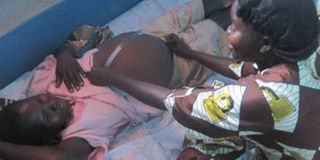Infant deaths can be avoided

A midwife attends to an expectant woman. File photo.
When Justine Nabifo, 24, started experiencing labour pains, her husband, Peter Wamanyanya, 37, of Nusu village in Bushiyi Sub-county, Bududa District, encouraged her to have the baby at home.
After all, Nabifo had successfully delivered two of their children at home without any incident.
As the labour pains intensified, her husband urged her to push but she quickly ran out of energy. She was now bleeding profusely.
Wamanyanya panicked and informed relatives who hurried for the village stretcher to rush Nabifo to Bududa hospital.
Nabifo was admitted but it was discovered that the child had died due to exhaustion.
On another bed in the same ward was 32-year-old Mary Nakhumitsa from Nametsi, who looked confused. She had just lost her baby.
Her mother, Margret Makuma, who is attending to her is equally confused because the doctors could not save Nakhumitsa’s baby.
But beyond all this is a wider problem of expectant women failing to get to health facilities on time for safe delivery.
Most expectant women, according to Agatha Nafuna, a retired midwife, choose to go to hospital when it is too late yet they “must deliver in the hands of qualified personnel”.
Imelda Tumuhirwa, the medical superintendent at Bududa hospital, believes such deaths can be avoided if expectant mothers get to a health facility early enough for proper care.
Available maternal and child health data at the Bududa hospital, according to Tumuhirwa, indicates that of 6,867 expectant mothers received during antenatal visits, only 1,905 deliveries are supervised by medics.
The percentage of deliveries in health facilities in the district have not changed much since 2009, when it declined to 24 per cent from 25 per cent in 2008.
According to Wilson Watira, the Bududa District chairperson, although the health infrastructure distribution is relatively fair, many health centres lack basic equipment to offer reasonable services.
“Many rural health units require rehabilitation in order to provide screening and counselling, medical treatment, home care, health education and Aids research,” he says.
A 2014 Unicef report indicates that 10 newborn babies die every minute, but majority of these deaths are preventable.
Another report, “Ending newborn deaths”, shows that half of newborn deaths across the globe could be prevented if mothers had access to health care and skilled midwifery.
Much of these deaths, Tumuhirwa says, happen as a result of premature birth and complications during birth, such as prolonged labour, pre-eclampsia and infection, which can be avoided if expectant mothers sought out health expert early enough.
Inaccessible health care
Muhammad Mulongo, the Bulambuli District health officer, says while prolonged labour, pre-eclampsia and infection account for most deaths of new babies, inaccessible health care overrides other the challenges.
“... more than 53 per cent of the people in the Elgon sub-region give birth at home because of inaccessible health centres with most of such women dying because of bleeding,” he says.
The first 24 hours of a child’s life, he says are the most dangerous, with more than one million babies dying each year on their first day, according to research published by Save the Children.
According to Joy Lawn, a global and newborn health expert and director of Centre for Maternal, Adolescent, Reproductive and Child Health, safe delivery in Africa is attached to some form of wealth with more than 36 million live births happening in Africa per year.
“Some 36 per cent of these are conducted at home, 12 per cent with traditional birth attendant, 2 per cent at home with a midwife while 50 per cent deliver at a health facility,” Lawn says.
Charles Kiggundu, a gynaecologist at Makerere University Medical School, notes that it is possible to prevent newborn baby deaths if essential health services were more equitably distributed.
Even distribution, he says, would reduce newborn mortality by 38 per cent.
He reveals that Uganda loses more than 5,000 mothers, 30,000 newborns and 35,000 stillbirths every year yet there is technology and policy guidelines that can ensure safety for the victims.
Between 30 and 40 per cent of infant deaths in Uganda, Kiggundu notes, occur due to poor care during pregnancy and delivery.
Barbara Burroughs the Save the Children Uganda country coordinator, says it will take 110 years for a child born in Africa to have the same survival rate as one born in Europe.
“Nearly 25 per cent of the infant deaths can be reduced by ensuring good hygiene such as washing hands, good cord care, breastfeeding and thermal protection,” she says.
However, Moses Mulumba, the executive director of Centre for Human Rights and Development says, the deaths could be a result of Uganda’s failure to abide by the Abuja Declaration, which requires 15 per cent of national budgets to be allocated to healthcare.
Records, according to Mulumba, show that a range of social, cultural and practical barriers could also be excluding many people from the formal healthcare system.
Child mortality
Stopping child mortality
According to the 2014 Save the Children report, “Ending newborn deaths” ending child deaths requires.
* Accountable declaration to end preventable newborn mortality, saving two million newborn lives a year as well as stopping the 1.2 million stillbirths.
* Ensuring that by 2025, every birth is attended to by trained and equipped health workers who can deliver essential newborn health interventions.
* Increasing expenditure on health to at least $60 per person.
* Training, equipping and supporting health workers, and scrapping fees for all maternal, newborn and child health services.




